Bearded dragons are diurnal reptiles that sleep at night. A healthy adult beardie will sleep around 8-12 hours each night. Their quirky sleeping habits and positions indicate they feel safe and comfortable in their environment.
As a bearded dragon owner, have you ever wondered why your pet snoozes in such odd positions? Catching your scaly friend sleeping upright or pancaked flat may look strange, but it’s perfectly natural reptile behavior.
While bearded dragons have some unique sleep behaviors compared to us mammals, they require the same basic conditions – a warm, dark, and quiet place to get adequate rest. Ensuring proper temperatures, lighting schedules, and enclosure enrichment will allow your pet to thrive on a natural sleep routine. As we explore the curiosities of bearded dragon sleeping positions and habits. You’ll learn what factors contribute to healthy slumber versus problematic sleep issues requiring attention.
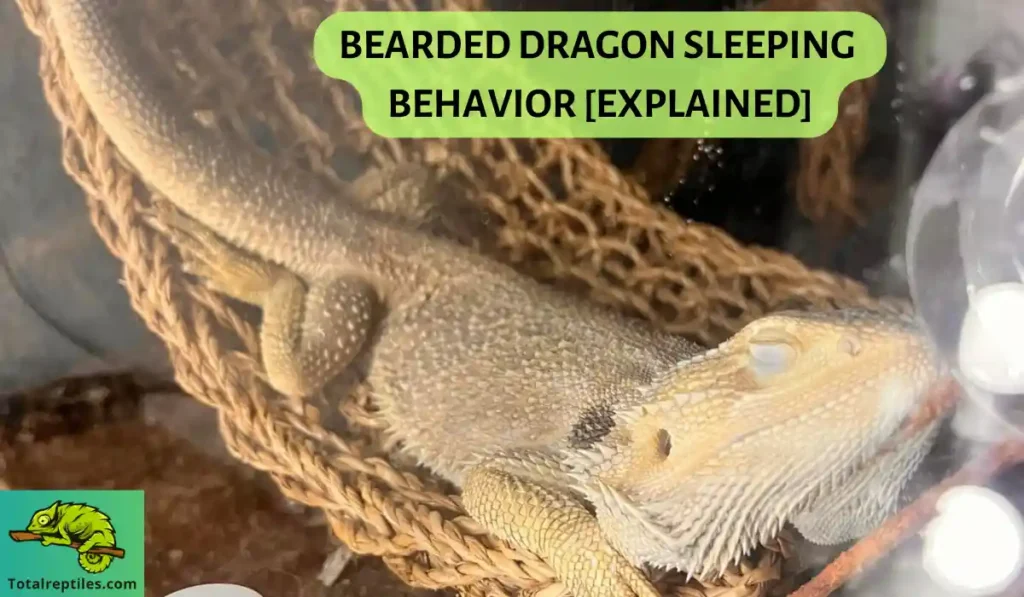
Bearded Dragon Sleep Patterns
As a bearded dragon owner, it’s helpful to understand their natural daily rhythms and sleep habits. See how these reptiles sleep and their regular sleep patterns.
Diurnal Nature
As diurnal reptiles, bearded dragons are most active during daylight hours and sleep at night. When sleeping, bearded dragons close their eyelids fully, just like humans. You will never see a bearded dragon sleeping with eyes open or half-open.
In the wild, they instinctively know to sleep at night when predators could be roaming about. In captivity with you, they’ll want to sleep when you turn the lights off at night to signal bedtime. Keeping them on a daytime schedule is important for their health.
How long do bearded dragons sleep?
On average, an adult bearded dragon sleeps around 8-12 hours per night. However, some individual beardies may consistently need more or less than others.
Younger, growing beardies tend to sleep longer than full-grown adults – think of it like a teenage growth spurt! During their first year, they may sleep up to 14 hours since they are developing rapidly.
Factors Affecting Sleep Needs:
- Age – babies need more sleep.
- Environment – improper heating and lighting disrupt sleep.
- Health issues – an ill beardie will sleep more.
- Brumation – extended sleep in winter.
- Individual nature – some are just sleepier!
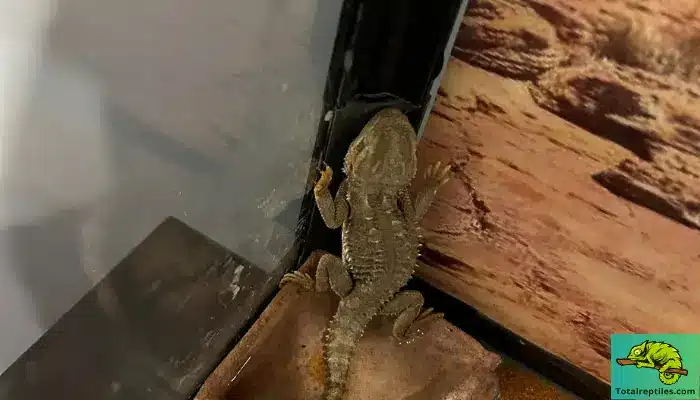
Circadian Rhythms
Bearded dragons have an internal “circadian clock” tuned to daylight just like humans do. Their cycles of sleeping, activity, appetite, metabolism, and more are tied to the presence or absence of sunlight.
Out in the wild, the sunrise and sunset regulate their daily rhythms. So, it’s critical to simulate proper day and night cycles for a pet beardie with a consistent lighting schedule. Maintaining these natural circadian rhythms supports their health.
Brumation
Brumation is a special kind of reptile hibernation. In the winter months, when daylight hours shorten, bearded dragons’ internal programming tells them to conserve energy.
So they will sleep MUCH more than usual, sometimes up to 23 hours a day! And they barely eat or poop. This brumation period can last 3-4 months. It’s perfectly natural seasonal behavior you shouldn’t worry about.
Just keep the tank a bit cooler and make sure fresh water is available. Never force a beardie out of brumation – let the cycle run its course! Then they’ll perk up in spring.
The sleep habits and rhythms of bearded dragons reveal how attuned they are to their environment. Pay attention to your pet’s normal sleep patterns and any changes. With proper lighting and heating, they will thrive on a schedule in sync with nature!
Ideal Sleep Conditions of Bearded Dragons
Creating the right environment is crucial for your bearded dragon to get quality nighttime sleep and stay healthy. Here are the ideal conditions to provide during their slumber.
Temperature
Temperature is one of the most important factors for a beardie’s sleep. At night, the temperature in their tank should drop to mimic natural cooling when the sun goes down.
The ideal nighttime temperature range is 70-75°F. This cooler environment signals their brain to sleep. Maintaining a proper day/night temperature gradient is critical.
Tips for nighttime temperatures:
- Turn off basking lamps at night.
- Use a ceramic heat emitter to prevent too much cooling if needed.
- Place the tank away from drafty areas or vents.
- Invest in a thermometer to monitor temperatures.
Improper heating is a common reason for sleep issues. If your beardie’s tank stays too warm at night, they won’t sleep well. Ensure temps are lowered appropriately.
Lighting
Closely tied to temperature is maintaining the proper light and dark periods. At night, the tank should be pitch black to simulate darkness. Any ambient light can disrupt quality sleep. Use lighting timers to ensure consistent daylight and nighttime schedules.
If needed, cover part of the tank at night to block out light. Allow 10-12 hours of continuous darkness for sound slumber. Proper lighting rhythms are vital for health!
Security
In the wild, bearded dragons feel vulnerable while sleeping, so they squeeze into rock crevices or dig burrows to feel safe and secure. Replicate this in their tank.
Provide a hide box just for sleeping. Adding branches, hammocks, and decor to climb on can make them feel more secure and comfortable sleeping. Give your beardie choices for where to sleep based on temperature, light exposure, and security.
Quiet
Bearded dragons are sensitive to noise disruptions while sleeping. Loud music, TV sounds, or people walking by can negatively impact their rest. Try to create a quiet ambient environment for your beardie at night. Their tank should be in an area away from too much noise or activity in the house.
Quality sleep is vital to your bearded dragon’s health. Prioritize their needs for proper temperature, lighting, security, and peace at night.
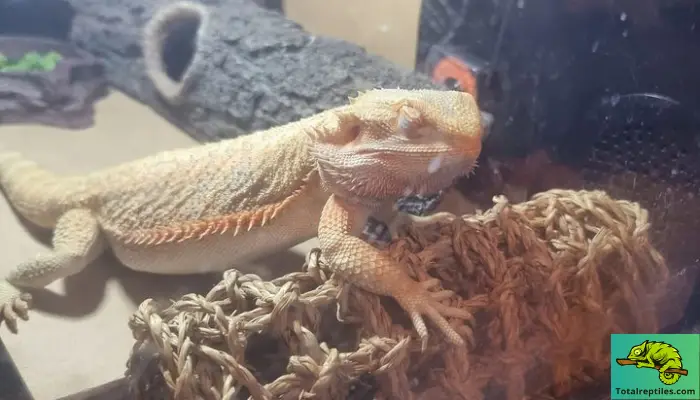
Sleeping Environment Enrichment
Proper stimulation and enrichment in your bearded dragon’s tank are important for encouraging healthy sleep patterns. Here’s how to create a secure, stimulating environment that reduces stress and supports quality slumber.
Climbing and Basking
In the wild, bearded dragons often sleep on branches or logs. They appreciate climbing and basking spots for sleeping, too.
Add sturdy branches, driftwood, or reptile-safe hammocks to give them high perches for sleeping: position basking platforms or ramps under the heat lamp for cozy lift-off spots. Having different levels and lookout spots makes them feel more secure while sleeping.
Hides and Burrows
Bearded dragons naturally tuck themselves into crevices and burrows to sleep in the wild. Providing hides satisfies their instinct for security.
Place cave hides on the warm end for snug sleep spots. Add substrates like reptile sand that allow them to burrow down before bedtime.
Hides with single entrances feel more enclosed and safe. Adding multiple hide options allows them to pick what suits their needs.
Plants and Decor
Live or artificial plants, like soft succulents, make great naturalistic sleep spots. Position them to create shaded, secluded areas.
Rock piles, logs, branches, and other decor can also be used as shelters while sleeping. Ensure any decor is securely positioned and sized appropriately to prevent injuries.
Stimulating Days
Keeping your bearded dragon active and engaged during daylight hours leads to better nighttime sleep.
Allow regular playtime outside their tank. Provide enrichment like puzzles and games. Vary their diet with novel veggies. A stimulating day means a restful night!
With a mix of basking spots, hides, plants, and other accessories, you can create an enriching environment that makes your bearded dragon feel secure and comfortable enough to get their needed beauty sleep!
How Do Bearded Dragons Sleep
Bearded dragons exhibit some funny and bizarre sleeping positions and habits. While the behaviors may look weird to us, they are perfectly normal! Here are some of the quirky ways beardies sleep:
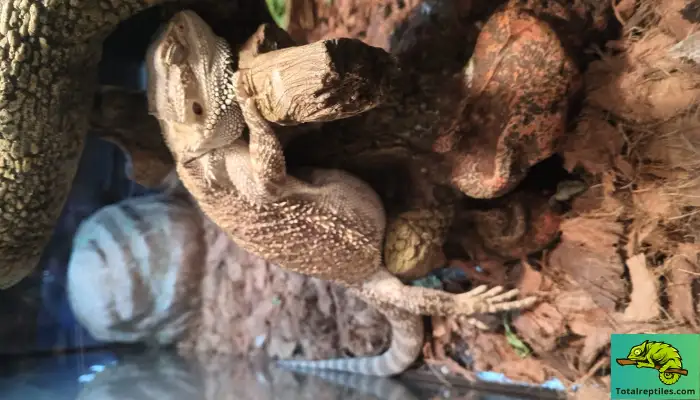
Snoozing Vertically
It’s common to find your bearded dragon sleeping in a fully vertical, upright position. They may stand up with their back pressed against the tank wall or decor all night long!
In the wild, beardies wedge themselves into trees and rocks to sleep above the ground, so vertical sleeping gives them that natural feeling of security and height.
Pancaking Out
The classic bearded dragon’s sleeping posture is pancaked out flat on their stomachs. Once they find a comfy, warm spot, beardies will flatten themselves as much as possible to soak up the heat.
Expect to find your beardie snoozing smushed down – they want maximum body contact! This allows them to absorb warmth efficiently.
Curled Up Cuties
Some bearded dragons ball themselves into a curled position to sleep, especially inside hides. They tuck their legs and tails in close to their body.
Rather than sprawling out to sleep, curling up tight may help them feel more secure and cozy. Their instincts tell them to protect their vulnerable underside.
Burrowed Down
In the wild, bearded dragons often sleep in burrows dug into the sand or soil. So don’t be surprised if your pet beardie tries burrowing into the substrate before bed.
They will squirm around, trying to cover themselves with a “blanket” of loose substrate.
Underwater Sleepers
Occasionally, some silly beardies will fall asleep in their water dish! While not recommended, a short nap in the water won’t hurt.
Monitor them closely and move them if they get too chilled from the water. Sleeping underwater is instinctual for some, but proper humidity and heating prevent this habit.
Your bearded dragon’s charming sleeping quirks reveal their instincts and wild nature. While the behaviors may seem odd, they show your pet feels comfortable and secure in their habitat with you. Embrace their kooky sleep habits!
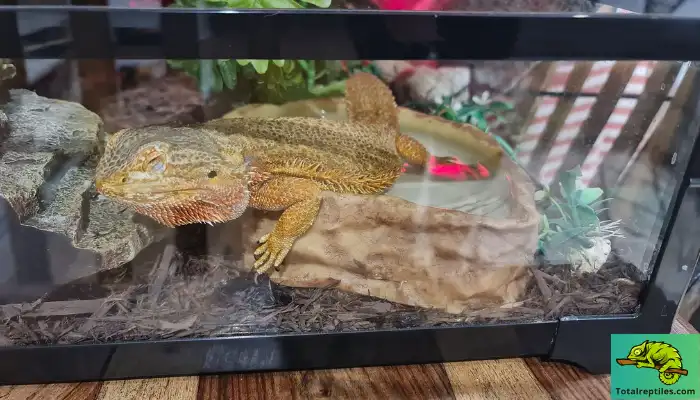
Comparison to Sleep in Other Reptiles
How does bearded dragon sleep compare to other reptiles like snakes, turtles, and lizards? Check out some important differences.
Sleep Cycles
Research shows bearded dragons experience REM and slow wave sleep cycles, similar to mammals and birds. Their sleep is more complex than other reptiles studied.
For example, over 75% of studies on turtle and crocodile sleep failed to detect REM/slow wave sleep patterns. Their sleep appears to be lighter.
Amount of Sleep
Bearded dragons sleep a solid 8-14 hours per night. This is a relatively large amount compared to many reptile species.
Snakes, for instance, only sleep around 13-15 hours per week in captivity. That’s just 2-3 hours a night! In the wild, snakes tend to sleep more during the day.
Sleep Positions
The vertical sleeping posture is unique to bearded dragons. Many other reptiles, like snakes, tend to sleep coiled up, not standing tall.
And bearded dragons always sleep with eyes closed, while reptiles like leopard geckos often sleep with eyes partly open.
Environment Cues
Bearded dragons rely heavily on light/dark cycles to regulate sleep, more so than some reptiles. Disrupting their lighting rhythms impacts their sleep.
Overall, while reptiles share some sleep characteristics, bearded dragons have some special adaptations and needs regarding their shut-eye.
Signs of Healthy vs Problematic Sleep
How can you tell if your bearded dragon is getting enough quality sleep? Look for these signs of healthy slumber versus problematic sleep issues requiring attention.
Indicators of Healthy Sleep
- Have regular sleep/wake cycles – alert during the day, sleepy at night
- Sleep in normal reptile positions – pancaked, curled up
- Respond normally to stimuli when sleeping lightly
- Sleep deeply and soundly through ambient night noises
- Feel relaxed when sleeping; muscles not tense
Other signs of healthy sleep include:
- Good appetite and energy levels during the day
- Normal activity and playfulness when awake
- Proper digestion and regular bowel movements
- Appropriate weight gain and growth
Why is My Bearded Dragon Sleeping So Much?
Bearded dragons may sleep too much; excessive sleep during the day or for multiple days/weeks may indicate an underlying issue.:
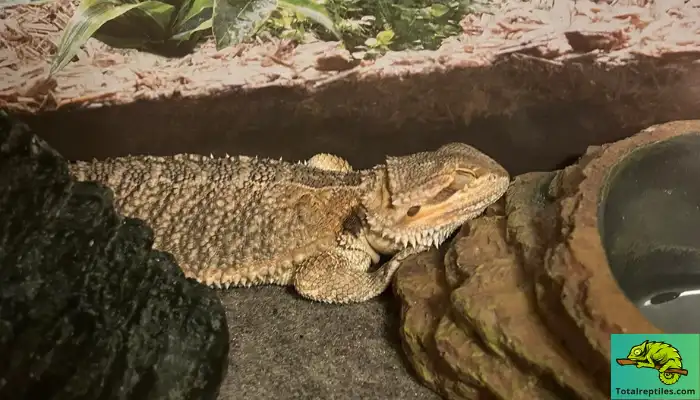
- Lighting is incorrect – too bright at night, insufficient daytime UVB
- Heating is improper – too hot or cold for quality sleep.
- The tank location is too noisy, bright, or high-traffic
- There is inadequate enrichment – lack of hide, climbing areas
Other issues that negatively impact sleep:
- Poor diet – malnutrition, dehydration, vitamin deficiencies
- Illness – infection, metabolic bone disease, parasites
- Stress – from handling, tankmates, environment
Signs of Problematic Sleep
Some owners ask Why is My Bearded Dragon Sleeping During the Day. The answer is Bearded dragons should not be sleeping all day. They are programmed to be awake and active when the sun is out. Sleeping too much during daylight hours is problematic. Noticeable symptoms that may accompany sleep problems include:
- Lethargy and lack of appetite during the day
- Sleeping more than normal hours
- Irregular sleep/wake schedule
- Restlessness, difficulty getting comfortable
- Unnaturally tense muscles when sleeping
- Lack of response to stimuli
If your bearded dragon shows signs of unhealthy sleep accompanied by these issues, take steps to improve their environment and care. Seek vet advice if symptoms persist. Quality sleep is vital to their well-being!
Caring For Your Sleeping Bearded Dragon
Caring for your bearded dragon while they are sleeping takes some special consideration. Here are tips on proper handling, adjusting their environment, and knowing when to call the vet.
Handling with Care
It’s best not to handle or disturb a sleeping bearded dragon unless necessary. Waking them suddenly can scare them and disrupt sleep cycles.
If you must move a sleeping beardie, do so slowly and gently. Make soothing sounds and avoid quick motions that may startle them as you transition to a new spot.
Adjusting the Sleep Environment
If your bearded dragon is having sleep issues like restlessness or lethargy, take a close look at their sleeping environment. Refer back to the ideal sleep conditions covered earlier.
- Is the temperature warm enough at night? Add a ceramic heat emitter if needed.
- Is the tank too exposed? Add more hides and barriers.
- Is the room too noisy or bright? Move their enclosure or add covers to block excess stimuli.
Sometimes, small tweaks to their sleep setup can make a big difference in helping your beardie sleep soundly through the night!
Knowing When to Seek Help
While some sleep struggles can be managed at home, contact your vet if sleep problems persist or your bearded dragon shows these symptoms:
- Refusal to eat
- Lethargy lasting over 48 hours
- Dark sleep patches under the eyes
- Weight loss
- Labored breathing
- Mouth swelling or discharge
- Abnormal positions or tremors
Unhealthy, excessive sleep paired with these issues could indicate illness or serious conditions like metabolic bone disease. Don’t delay getting veterinary help for stubborn sleep problems.
Caring for a sleeping bearded dragon is all about respecting their slumber but taking action if sleep isn’t coming easy for your pet.
FAQ
Why is my bearded dragon sleeping upright?
Sleeping in an upright or vertical position against the tank gives beardies a sense of security and height, simulating how they sleep wedged into trees/rocks in the wild.
Is it normal for bearded dragons to sleep a lot?
While they are diurnal, sleeping more than 14 hours could indicate an underlying health issue. Monitor for other symptoms and ensure proper lighting, heating, enrichment, and veterinary attention if needed.
Are Bearded Dragons Heavy Sleepers?
Yes, bearded dragons experience REM and slow wave sleep cycles, meaning they sleep quite heavily and soundly like humans. Their sleep is complex.
How do I know if my bearded dragon is sleeping or ill?
Look for closed eyes, rhythmic breathing, flattened posture, and lack of response to stimuli to confirm sleep. Lethargy plus appetite loss could mean illness.
Conclusion
Understanding your bearded dragon’s sleep requirements and patterns is crucial for providing proper care. Now you know all about their unique diurnal sleep rhythms, brumation in winter, temperature and lighting needs, quirky sleep habits, and signs of sleep problems.
While some sleeping positions may look strange, they show your beardie feels safe and comfy. Support healthy sleep by meeting their needs for heat, enrichment, and undisturbed rest.
If excessive sleepiness occurs, rule out husbandry issues first, then consult a vet if needed. Monitor your pet’s sleep cycles, and you’ll quickly learn their normal routine.

